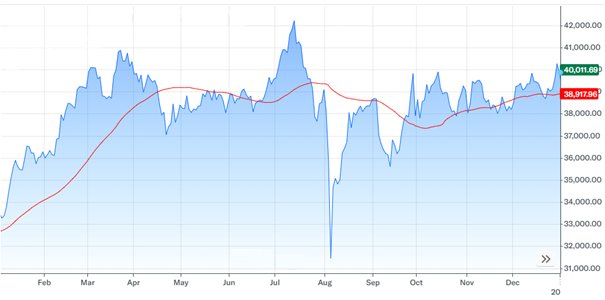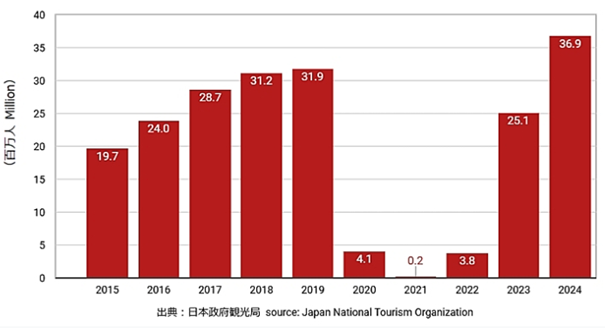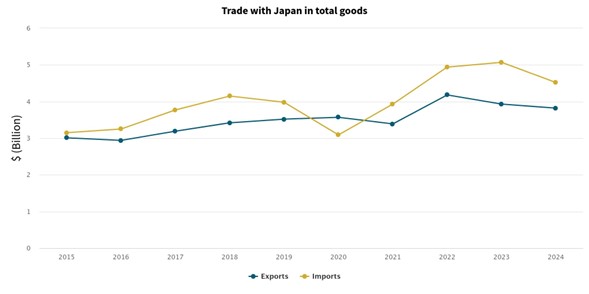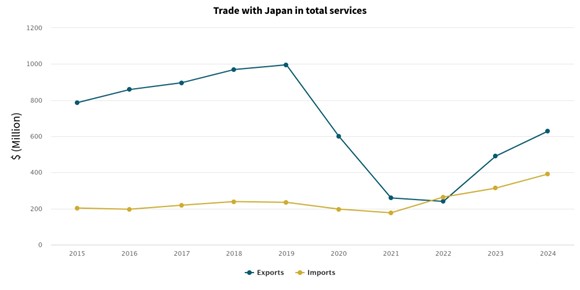Supply Chains, Primary Products, Manufacturing (excludes F&B):
On this page
Summary
- 2024 saw mixed results for the Japanese economy. Japan has narrowed its trade deficit, and a record number of foreign tourists visited Japan. Japanese business profits look set to hit record highs for a fifth consecutive year and the stock market is at an all-time high. Interest rates are rising, and inflation is within the Bank of Japan’s target range, with the core consumer price index at 2.5%.
- But growth was sluggish at an estimated 0.3-0.4% for the 2024/25 financial year. Real wages fell, bankruptcies hit record highs, and surveys indicate that Japanese businesses looking to invest overseas are more cautious than they were a year ago.
- Trade between New Zealand and Japan declined slightly compared to the previous year. For the year ending September 2024 two-way trade was NZD9.36bn, compared to NZD9.8bn the year prior. Goods exports were relatively flat overall. Growth in horticulture (up 16%) and meat (up 26%) exports was offset by a decline in dairy (down 16%). Services trade remains below pre-pandemic levels due to the slow recovery of outbound tourism from Japan. Student numbers have recovered to pre-pandemic levels.
- Prospects for 2025 are positive. The Japanese economy is expected to grow 1.1-1.2%, with wage growth expected to be above inflation. This would help push Japan into the “virtuous cycle of growth” that the government has been aiming for. But the possibility of tariffs from the US, which Japan enjoys a significant trade surplus with, and a further slowdown in China’s economy as Japan’s largest trading partner could dampen these prospects.
- Japan needs to make progress on some of the structural issues facing its economy. Low productivity and an ageing and shrinking population continue to weigh heavily on growth prospects. Rising interest rates will increase pressure on Japan to manage down its government debt (an estimated 254.6% of GDP in 2024). Japan is also aiming to improve its energy security. Despite these challenges Japan remains the fourth largest economy in the world, an integral part of global trade, and an important trading and investment partner for New Zealand.
Report
The Japanese economy in review – 2024
In Japan the beginning of 2024 saw a lot of positive commentary about the state of the economy and a feeling that Japan was getting its economic mojo back. However, 2024 has been a bit of a mixed bag.
The Japanese economy had been recovering at a moderate pace during 2024. Nominal wage growth reached the highest level in 33 years, but inflation-adjusted real wages have been falling. Growth has remained sluggish, estimated to be 0.3-0.4% for the 2024/25 financial year (1 April 2024 to 31 March 2025).
Japanese companies are expected to post record profits for a fifth consecutive year. Tech and AI sectors have seen profits improve over the past year, offsetting a struggling automobile sector that is recovering from last year’s vehicle testing certification scandals. Stocks finished the year on a positive note, with the Nikkei Stock Average reaching its highest ever level and recording a 19% annual rise.

The tourism sector had a particularly strong year. A record 36.87 million tourists visited Japan in 2024, well above the pre-pandemic peak of 32 million in 2019. The weak yen made Japan a more affordable and attractive destination. While this has been a boon for Japan’s tourism earnings, it has not been without controversy as it has led to concerns in Japan about the impact of overtourism on local communities in some of the most popular areas such as Kyoto and Mt Fuji.

2024 was a more challenging year for small and medium businesses. ‘Zombie businesses’, i.e. those struggling to make sufficient operating profits to pay down debts, have been succumbing to bankruptcy at an increased pace. The end of COVID era support, rising inflation, and interest rate increases for the first time in 17 years have seen bankruptcies exceed 10,000, the highest number in 11 years. More than 70% of bankruptcies had debts of less than JPY100m (NZD1.15m).
Consumer sentiment remains depressed. Food (particularly rice, up 60% in 2024) and energy price increases have had significant impacts. Households are struggling and unions are pushing hard for significant wage increases in 2025, given continued record profits being made by large Japanese companies.
International trade snapshot
Japan had an overall trade deficit in 2024 of JPY5.3tril (NZD59.7bn), a decline of 44% from 2023. It marks the fourth straight year of trade deficits. Exports hit a record high JPY107.9tril (NZD1.2tril), but the weakening yen inflated the value of imports. Japan has a significant trade surplus with the US, standing at JPY8.6tril (NZD96.9bn). China remains Japan’s #1 trading partner, with Australia coming in at #3 due to the significant amount of energy imports.
Trade with New Zealand
Trade between Japan and New Zealand declined slightly compared to the previous year. For the year ending September 2024 two-way trade was NZD9.36bn, compared to NZD9.8bn the year prior. Japan was New Zealand’s fifth largest trading partner and fourth largest export market during this period (Source: Stats NZ
Goods exports remained relatively flat compared to last year. A 16% drop in dairy exports to Japan was offset by a 16% increase in horticulture and 26% increase in meat exports. Cost of living pressure has seen some reduction in domestic demand in the food and beverage sector, but the strength of inbound tourism to Japan has helped to offset this decline.
Table 1: New Zealand Goods Exports to Japan bu Industry Year Ending November 2024
| Rank | Industry | Year ending November 2024 | ||
| $ Millions | % Change | % Share | ||
| 1 | Dairy | 893 | -16 | 24 |
| 2 | Horticulture | 743 | 6 | 20 |
| 3 | Metal and metal products | 610 | 1 | 16 |
| 4 | Meat and meat products | 472 | 26 | 13 |
| 5 | Forestry and wood products | 321 | -6 | 9 |
| 6 | Miscellaneous F&B products | 217 | -8 | 6 |
| 7 | Fisheries | 73 | 6 | 2 |
| Subtotal of leading industries | 3,329 | N/A | 90 | |
| Other goods | 372 | N/A | 10 | |
| Total | 3,701 | 0.2 | 100 | |
Source: Global Trade Atlas
| New Zealand Goods Trade with Japan (NZD year to September 2024): | |||
| Total Goods Trade | $8.34bn | ||
| NZ exports | $3.82bn | NZ imports | $4.52bn |
| Main exports | Dairy Products; Aluminium; Fruits and Nuts; Meat and Edible Offal; Wood | Main imports | Vehicles (over 50% of total import value); Mineral Fuels and Oils; Mechanical Machinery; Electrical Machinery |

Services trade remains well below pre-pandemic levels, primarily owing to a slow recovery in outbound tourism from Japan. In the year to October 2024, nearly 65,000 Japanese visitors came to New Zealand. This represents a 65% recovery from pre-pandemic levels. The weak yen has dampened demand in Japan for overseas travel across almost all destinations, with people choosing to travel domestically instead.
Student numbers have seen a swifter recovery, returning to near pre-pandemic levels.
| New Zealand Services Trade with Japan (NZD year to September 2024): | |||
| Total Services Trade | $1.02bn | ||
| NZ exports | $628.68m | NZ imports | $391.3m |
| Main exports | Travel; Business Services; Telecommunications and Information Services; Government Services | Main imports | Travel; Business Services; Telecommunications and Information Services; Charges for Intellectual Property |

Government budget
Just prior to the New Year the Ishiba administration unveiled its draft budget for the 2025/26 financial year. The draft budget will be subject to negotiation with opposition parties in the Diet. Key themes from the draft budget include:
- Despite tax revenue expected to reach a record high, a budget deficit is estimated.
- Significant cost pressures on the budget come from increasing social security costs, representing one third of the budget (1.5% increase from last financial year).
- Defence spending gets a boost, marking 13 consecutive years of defence increases (9.4% increase from last financial year).
- Support to drive growth in GX (green transformation), AI and semiconductor industries.
- Approximately a quarter of the budget will be used for existing debt servicing, with an approximate equal amount of new bonds being issued. New bond issuances would represent the lowest in 17 years.
Outward investment – caution among investors
The Japan Bank for International Cooperation recently released the results of its 2024 survey on trends in Japanese foreign direct investment (FDI) overseas. In general, Japanese business interest in investing overseas saw a decline in 2024. Key reasons included a slowdown in global demand, slowdown in the Chinese economy, and increasing geopolitical risks.
India maintained its top ranking as the most promising country for FDI for Japanese investors, with China continuing its slide further down the list to sixth. The US, Mexico and ASEAN countries are also ranked highly. The need to strengthen supply chains and bring production closer to expanding markets were important factors companies were considering when looking at investment destinations. New Zealand ranked 27th equal in the list of promising destinations for FDI from manufacturing companies, and 23rd for non-manufacturing companies.
The full report can be found here(external link).
Interest rate normalisation?
In March 2024 Japan raised interest rates for the first time in 17 years, and again in January 2025, taking the Bank of Japan’s policy rate to 0.5%. The Governor of the Bank of Japan flagged the possibility of further rate increases should Japan’s economic recovery continue. Japan’s neutral rate is estimated to be around 1.5-2.0% (where interest rates are equivalent to inflation) and commentators assess Japan may reach this point sometime in 2026 if the current trend continues. After years of interest rates being at or below zero, this would restore interest rate normalisation in Japan. This should also help strengthen a depreciating yen, a key aim for the Bank of Japan.
Projections for 2025
Economist and government estimates predict real growth of 1.1-1.2% for 2025/26 financial year, with wage growth expected to be above inflation. This would help push Japan into the “virtuous cycle of growth” that the government has been aiming for. Businesses are also expecting steady profit growth into 2025.
The Ministry of Finance expects that domestic consumption and business investment will be the main drivers of growth. Keidanren (Japan Business Federation) announced a new target to increase domestic investment to JPY 135tril (NZD 1.55tril) in 2030 and JPY 200tril (NZD 2.29tril) in 2040. Amid Japan’s rapidly ageing and shrinking population labour shortages remain a concern and a significant inhibitor of growth.
There is cautious optimism that 2025 will see an uptick in productivity. The zombie businesses that perished in 2024 will in theory create space for the emergence of new enterprises. Research released this month from the Research Institute of Economy, Trade and Industry sought to estimate the impact of AI on macroeconomic productivity in Japan, finding AI provided a 0.5-0.6% boost to labour productivity between September 2023 and October 2024. The impact of AI on productivity is expected to continue to grow, albeit at declining rates.
Commentators in Japan have outlined two main factors that may impact Japan’s economic prospects in 2025. The first is the potential impact of tariffs that the Trump Administration might impose. Secondly, the impact of any economic slowdown in China, as Japan’s largest trading partner.
More reports
View full list of market reports(external link)(external link)
If you would like to request a topic for reporting please email exports@mfat.net
Sign up for email alerts
To get email alerts when new reports are published, go to our subscription page(external link)
Learn more about exporting to this market
New Zealand Trade & Enterprise’s comprehensive market guides(external link) export regulations, business culture, market-entry strategies and more.
Disclaimer
This information released in this report aligns with the provisions of the Official Information Act 1982. The opinions and analysis expressed in this report are the author’s own and do not necessarily reflect the views or official policy position of the New Zealand Government. The Ministry of Foreign Affairs and Trade and the New Zealand Government take no responsibility for the accuracy of this report.
Copyright
Crown copyright ©. Website copyright statement is licensed under the Creative Commons Attribution 4.0 International licence(external link). In essence, you are free to copy, distribute and adapt the work, as long as you attribute the work to the Crown and abide by the other licence terms.

